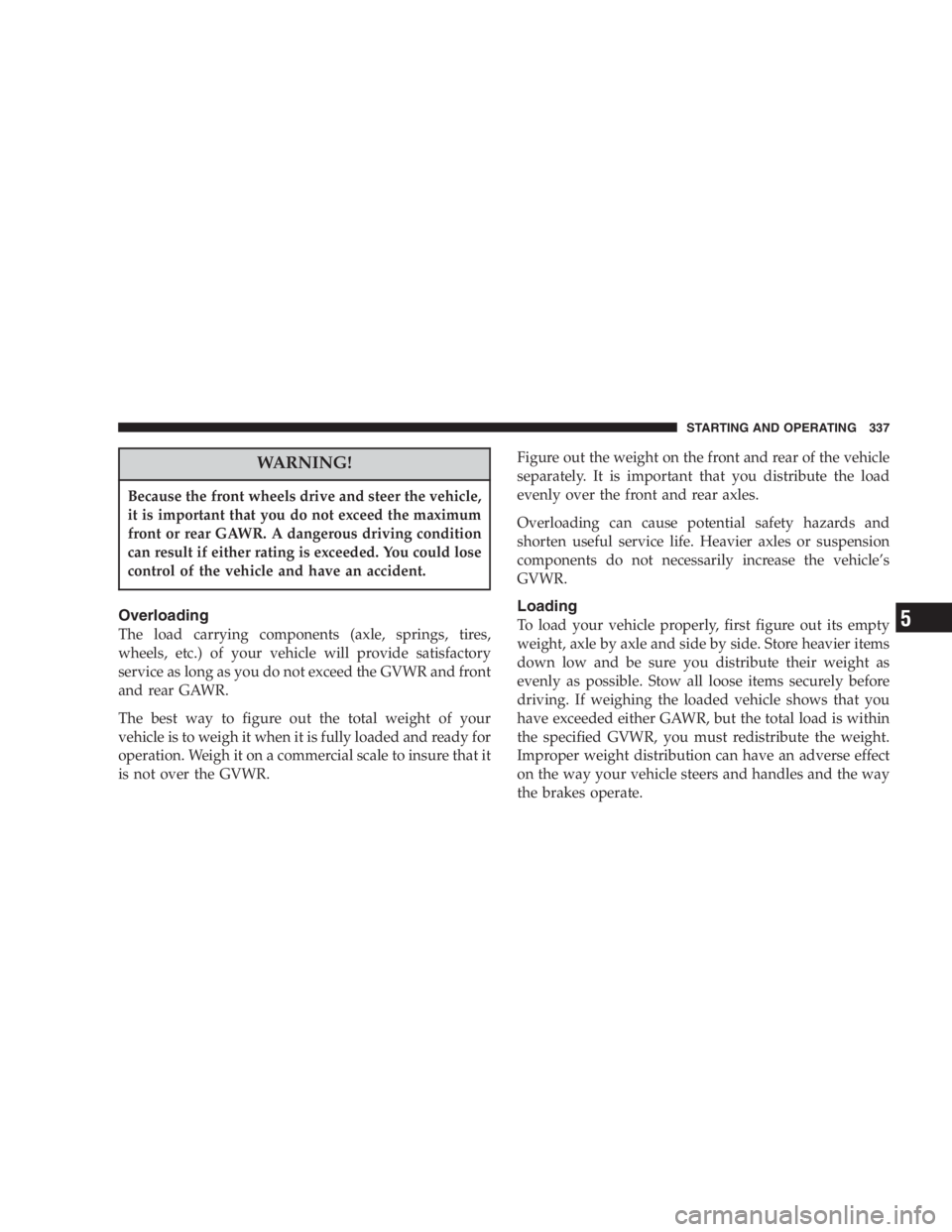Page 324 of 480

WARNING!• Do not use a tire, wheel size or rating other than that
specified for your vehicle. Some combinations of
unapproved tires and wheels may change suspen-
sion dimensions and performance characteristics,
resulting in changes to steering, handling, and brak-
ing of your vehicle. This can cause unpredictable
handling and stress to steering and suspension com-
ponents. You could lose control and have an accident
resulting in serious injury or death. Use only the tire
and wheel sizes with load ratings approved for your
vehicle.
• Never use a tire with a smaller load index or capacity,
other than what was originally equipped on your
vehicle. Using a tire with a smaller load index could
result in tire overloading and failure. You could lose
control and have an accident.
• Failure to equip your vehicle with tires having
adequate speed capability can result in sudden tire
failure and loss of vehicle control. CAUTION!Replacing original tires with tires of a different size
may result in false speedometer and odometer read-
ings.
Alignment And Balance
Poor suspension alignment may result in:
• Fast tire wear.
• Uneven tire wear, such as feathering and one-sided
wear.
• Vehicle pull to right or left.
Tires may also cause the vehicle to pull to the left or right.
Alignment will not correct this condition. See your dealer
for proper diagnosis.324 STARTING AND OPERATING
Page 337 of 480

WARNING!Because the front wheels drive and steer the vehicle,
it is important that you do not exceed the maximum
front or rear GAWR. A dangerous driving condition
can result if either rating is exceeded. You could lose
control of the vehicle and have an accident.
Overloading
The load carrying components (axle, springs, tires,
wheels, etc.) of your vehicle will provide satisfactory
service as long as you do not exceed the GVWR and front
and rear GAWR.
The best way to figure out the total weight of your
vehicle is to weigh it when it is fully loaded and ready for
operation. Weigh it on a commercial scale to insure that it
is not over the GVWR. Figure out the weight on the front and rear of the vehicle
separately. It is important that you distribute the load
evenly over the front and rear axles.
Overloading can cause potential safety hazards and
shorten useful service life. Heavier axles or suspension
components do not necessarily increase the vehicle ’ s
GVWR.
Loading
To load your vehicle properly, first figure out its empty
weight, axle by axle and side by side. Store heavier items
down low and be sure you distribute their weight as
evenly as possible. Stow all loose items securely before
driving. If weighing the loaded vehicle shows that you
have exceeded either GAWR, but the total load is within
the specified GVWR, you must redistribute the weight.
Improper weight distribution can have an adverse effect
on the way your vehicle steers and handles and the way
the brakes operate. STARTING AND OPERATING 337
5
Page 371 of 480
MAINTAINING YOUR VEHICLECONTENTS � 2.4L Engine ...........................374
� 3.3L/3.8L Engines ......................375
� Onboard Diagnostic System — OBDII........376
� Emissions Inspection And
Maintenance Programs ...................377
� Replacement Parts ......................378
� Dealer Service .........................378
� Maintenance Procedures ..................379
▫ Engine Oil ..........................379 ▫ Engine Oil Filter ......................383
▫ Drive Belts — Check Condition And Tension . . 383
▫ Spark Plugs .........................384
▫ Engine Air Cleaner Filter ................384
▫ Catalytic Converter ....................385
▫ Maintenance-Free Battery ................387
▫ Air Conditioner Maintenance .............388
▫ Power Steering — Fluid Check ............390
▫ Front Suspension Ball Joints ..............390
7
Page 390 of 480

frame with the direction of airflow (away from the
blower motor and towards the center of the car).
Refer to the “ Maintenance Schedules ” section of this
manual for the recommended air conditioning filter
replacement intervals.
Power Steering — Fluid Check
Checking the power steering fluid level at a defined
service interval is not required. The fluid should only be
checked if a leak is suspected, abnormal noises are
apparent, and/or the system is not functioning as antici-
pated. Coordinate inspection efforts through a certified
DaimlerChrysler Dealership. � WARNING!Fluid level should be checked on a level surface and
with the engine off to prevent injury from moving
parts and to insure accurate fluid level reading. Do
not overfill. Use only manufacturers recommended
power steering fluid.
If necessary, add fluid to restore to the proper indicated
level. With a clean cloth, wipe any spilled fluid from all
surfaces. Refer to Recommended Fluids, Lubricants, and
Genuine Parts for correct fluid type.
Front Suspension Ball Joints
The front suspension ball joints are permanently sealed.
No regular maintenance is required for these compo-
nents.390 MAINTAINING YOUR VEHICLE
Page 428 of 480
Once a Month
• Check tire pressure and look for unusual wear or
damage.
• Inspect the battery and clean and tighten the terminals
as required.
• Check the fluid levels of coolant reservoir, brake
master cylinder and transmission; add as needed.
• Check all lights and all other electrical items for correct
operation. At Each Oil Change
• Change the engine oil filter.
• Inspect the exhaust system.
• Inspect the brake hoses.
• Inspect the CV joints and front suspension compo-
nents.
• Check the automatic transmission fluid level.
• Check the coolant level, hoses, and clamps.428 MAINTENANCE SCHEDULES
8 M
A
I
N
T
E
N
A
N
C
E
S
C
H
E
D
U
L
E
S